08 Dec 2020
03 Nov 2020
Rating and Reviews
CheckoutSmart blog

08 Sep 2020
It's obvious when you come to think about it, when online grocery shoppers select products to put in their basket, a product rating out of five is always more important than the number of reviews, right?
Well, wrong actually and not just wrong occasionally, it's wrong most of the time. From our research of 3,710 online supermarket shoppers we know that when the average ratings for two similar products are different by as much as 0.3 e.g. 4.2 vs 4.5, then the number of reviews is much more important in product choice. Let me give you an example of this:
If you have two very similar products selling online and Product A has an average rating of 4.2 from 30 reviews, while Product B has an average rating of 4.5 from 10 Reviews, then you would think they'd be pretty close in terms of share of choice? Our research shows that in reality, Product A, (the one with the lower rating) is chosen twice as often as Product B. That's right, even though Product B has an obvious rating advantage, shoppers still choose Product A 67.9% of the time.
Increasing the number of reviews you have, regardless of the average ratings, will significantly improve your sales in online supermarkets.
We surveyed members of our regular promotional cash back program Smart Activation about all manner of things related to their attitude and experience of online shopping which included how they view and use supermarket product reviews.
We looked at the question of the rating score out of five vs. the number of reviews in two ways:
> Shoppers ranked in order of importance parts of a mocked up supermarket product review summary
> Shoppers chose between paired alternative combinations of product ratings & reviews for "similar" products.
- CheckoutSmart research (3,710 online grocery shoppers)

 We presented supermarket online shoppers with the mocked up product review summary above and asked them to rank in order of importance, the six elements shown below. From over 3,700 responses the average ranking was:
We presented supermarket online shoppers with the mocked up product review summary above and asked them to rank in order of importance, the six elements shown below. From over 3,700 responses the average ranking was:Clearly the average "star rating" is the most important element, with the number of reviews, second. The date of last review or "recency" is a close third, and then the "text of last review" after this the "disclaimer" and "headline" are a distant 5th and 6th.
This seems to contradict our comment above that the number of reviews is more important than the average rating. We believe this is because this question is too far from the real experience of the virtual supermarket shelf. When asked in isolation the respondent's rational brain says "star rating" as this is for this one product. In reality, shoppers are much more likely to be using ratings & reviews to help choose between two similar products. This was the scenario we researched next.
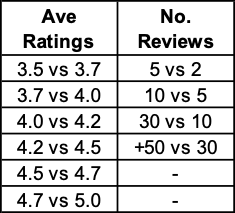
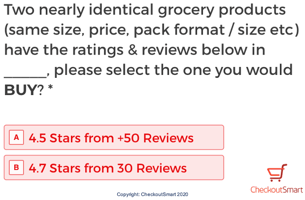
For this, we presented online grocery shoppers with six random alternative scenarios from a total of 24, where the star rating and the number of reviews were relatively close but in the opposite direction, i.e. one product had a higher star rating but lower number of reviews and vice versa.
The "blank" in the image on the right was filled with their favourite online retailer (a question from earlier in the survey).
The 22,260 responses to these questions were then analysed to understand the relative share of choice - or market share if you prefer - for each product (Product A or Product B). The alternatives test included 6 average star ratings and 4 reviews = 24 options.
Note: Product A with an average star rating of 3.5 from five reviews vs. Product B with an average star rating of 3.7 from two reviews.
The results showed a clear preference for choosing the SKU with more reviews:

In 5 out of 6 pairings more than 75% of online grocery shoppers would choose the products with a lower average star rating but more reviews. The only exception was for 3.7 vs. 4.0 where it was still 62%.
The average star rating comparison of 3.7 vs. 4.0 proved to be an outlier across all ratings alternatives. We believe it is because it is comparing across the 3 vs. 4 boundary, which we can see here:
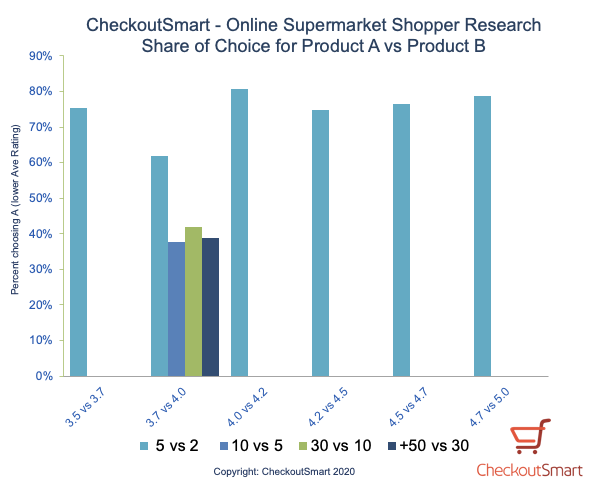
So when the number of reviews comparison is greater than 5 vs, 2, it looks like the psychological barrier between average ratings of 3.. and 4.. is more important to online grocery shoppers when deciding between two similar products, than a small number of reviews. However, this is an outlier:
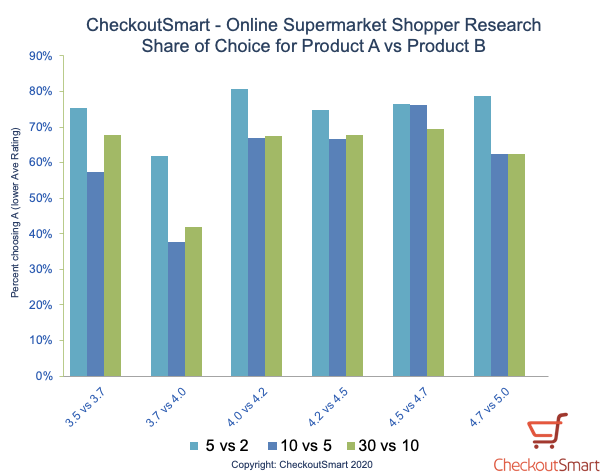
In all other cases there is a strong preference for the product with the lower average star rating, with an average of 2/3 choosing this combination vs. only 1/3 for the one with the higher average star rating.
This preference for the lower average star rating begins to fade beyond 30 reviews, as you can see when we add in the 30 vs. +50 reviews alternative.
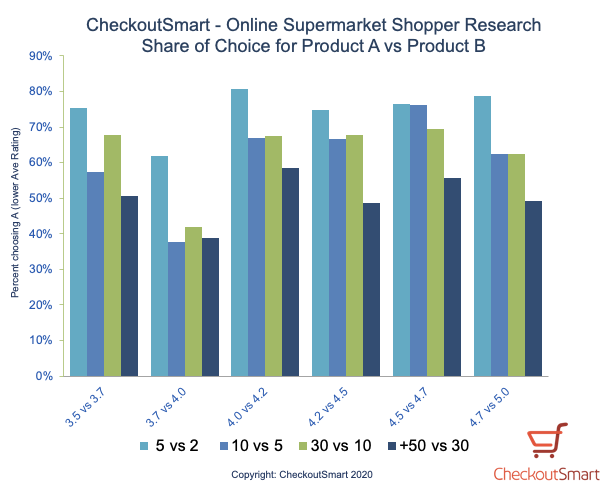
For this amount of review alternatives, the average product choice is exactly 50% across all of the average star ratings, so the number of reviews is still having an impact. This correlates with other research we have seen, highlighting that the impact of increasing number of reviews begins to tail off after 30. Of course it does have an impact beyond that, but it is significantly more important to get your online product reviews up to 30 than to drive them beyond that.
The main reason for adding reviews beyond 30 becomes not because you want more reviews per se, but because of review freshness. Once you have more than 30 online supermarket product reviews on all your products in all the retailers, it is now important to keep those reviews fresh.

![]()
”My husband loves these, and when I’m making them up for him in the morning, they’re simple to do and look just like what you’d get in a coffee shop”
![]()
”Nice refreshing water and you can tell the difference between the cheaper brands due to level of minerals. ”
08 Dec 2020
03 Nov 2020
© Copyright 2024, Checkout Smart Ltd. All Right Reserved.